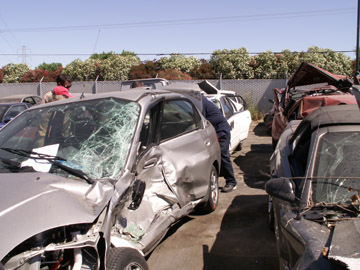Same Stooges. Different World. Finer Wine.

Iggy Pop at the All Tomorrow’s Parties music festival in Minehead, England.
THERE are the Stooges, from Ann Arbor, Mich., accidental inventors of punk, in the summer of 1970, on nationwide television. And there’s Iggy Pop, their singer: bare torso and sausage-casing jeans, silver gloves, dog collar, chipped front tooth.
Multimedia
Readers’ Opinions
The song is “TV Eye,” and they have gotten wickedly good at their primitive groove — as good as they will ever get. Iggy weaves in and out of the beat: one second borne by the music, one second abstracted from it. Suddenly he does a violent knock-kneed dance and slips into the audience, gone except for his wounded-animal noises.
“There goes Iggy, right into the crowd,” says the host of the special NBC program “Midsummer Rock.” It’s Jack Lescoulie, an announcer on the “Today” show, the Al Roker of his day. In his late 50s he looks like the anti-Stooge: professional, good-natured, well fed, well insured.
After a commercial break we see Iggy crawling on the stage. “Since we broke away for our message, Iggy has been in the crowd and out again three different times,” Mr. Lescoulie says. “They seem to be enjoying it, and so does he.” The camera centers on a scrum of teenagers looking downward. Iggy surfaces, hoists himself up so he’s standing on shoulders, and remains aloft, pointing forward like the prow of a ship. Next he’s scooping something out of a jar, wiping it on himself, flinging it around. “That’s peanut butter,” Mr. Lescoulie says, incredulous.
I’M going to be straight,” Iggy Pop said recently, talking about that film, which circulated for years in certain circles and is now of course available on YouTube. “I was more than a little high.”
He was often more than a little high. But these days Iggy Pop, a k a Jim Osterberg, is ferociously grounded. He swims and practices a form of tai chi, and his only vice, he says, is a few glasses of Bordeaux. Coming up on his 60th birthday, he bears signs of age: creased and ropy, he limps from cartilage lost in his right hip, and can’t hear well over ambient noise.
For the first time in 34 years, however, he and the members of his onetime band are putting out a new record: “The Weirdness,” which will be released by Virgin on March 6. (Careful historians will say 37 years: this is the version of the Stooges that made “Fun House,” around the time of the peanut butter concert — the brothers Ron and Scott Asheton on guitar and drums and Steve Mackay on tenor saxophone.)
In the intervening years they too have changed. As has the world around them.
Once upon a time Iggy and the Stooges defined themselves against the Lescoulies of the world: they were outrageous, truculent, elemental. But these days it seems there are more Iggys than Lescoulies. Everyone’s subversive, everyone’s perverse. What can the Stooges be, if not a band that defines itself against the rest of the world? What happens when they’re old and experienced, and punk attitudes, already in their third generation, have infiltrated so many corners of the culture? How do they climb back into that frame of mind?
Video
More Video »BREAKING up” doesn’t exist anymore. A band only has extended periods of downtime.
The Stooges’ downtime was a little more down than others. Ron Asheton used to say that Iggy had become too self-involved for the Stooges to play together again. Scott Asheton pursued Iggy at various points over the last 10 years, and the answer was always no. “I wasn’t going to go backwards,” Iggy explains now. “And I wasn’t going to do anything to what I thought was a great band.”
At some point, however, the incentives just became too powerful: prime gigs at the best rock festivals in the world, both the best-paid and the most creatively run.
Plus, what else was there to do? Scott Asheton, who lives in Florida, had been working in construction. His brother, Ron, had been in a series of bands that hadn’t made a stir, still living in his boyhood home on the west side of Ann Arbor, where the band had its first rehearsals. (All three went to Ann Arbor High together.)
Iggy needed the Ashetons just as much. “We managed to stay in a band together during a protracted period of failure,” he said of those early days, gigging and making records and living in a filthy house. “No rewards. No approval. No money. These are really the only guys I know. That doesn’t mean, ‘Oh, shucks, I like them so much.’ I mean, we lived together.”
Besides, “I’d hit a wall playing alone, in my solo music,” he said. “I was just at wit’s end about what to do — bands, songwriting, everything.”
He invited the Ashetons to work on a few songs with him for his album “Skull Ring” in 2003. A week after they convened, the Coachella Valley Music & Arts Festival floated the idea of a Stooges reunion show. (They did the show; Iggy wouldn’t say how much they were offered, though he does say that the Stooges now get paid much better than he did for concerts during his solo career.) And the bassist Mike Watt came on board, once of the Minutemen, to take the place of Dave Alexander, who died in 1975.
Before they all headed into the studio, Mr. Watt flew to Florida to go over the new songs, and Iggy gave him a lesson about finding his “inner stupidity.”






 Foxx was more than the band’s singer. He conceived of Ultravox not as a rock band but a design concept, and he meticulously co-ordinated all aspects of the band’s production – image and words as well as sound – to produce a consistent ‘sonic fiction’. Foxx’s striking sleeve designs are as important as the music (as Peter Saville told me in the interview in last issue’s FACT, Foxx’s cover art for ‘Systems of Romance’ was an important influence on his own work for Factory).
Foxx was more than the band’s singer. He conceived of Ultravox not as a rock band but a design concept, and he meticulously co-ordinated all aspects of the band’s production – image and words as well as sound – to produce a consistent ‘sonic fiction’. Foxx’s striking sleeve designs are as important as the music (as Peter Saville told me in the interview in last issue’s FACT, Foxx’s cover art for ‘Systems of Romance’ was an important influence on his own work for Factory). 'My Sex' is like cyber-theorist Donna Haraway's Cyborg Manifesto nigh-on a decade ahead of time, and better - Ballard's condensed novels further compressed and spliced with Burroughs/ Warhol in a simulation of a post-social(ist) ex-human POV. The vocal - tentative, thin, distant - is less sung than (newsreel) reported, a radio-signal beamed back from the near-future. And the music - a sparse, plaintive, Satie-electric piano fugue - plays like nostalgia from an era (then) yet to come - the lost/ last sounds of the human echoing in the abandoned brutalist precincts of an alternate 1980s.
'My Sex' is like cyber-theorist Donna Haraway's Cyborg Manifesto nigh-on a decade ahead of time, and better - Ballard's condensed novels further compressed and spliced with Burroughs/ Warhol in a simulation of a post-social(ist) ex-human POV. The vocal - tentative, thin, distant - is less sung than (newsreel) reported, a radio-signal beamed back from the near-future. And the music - a sparse, plaintive, Satie-electric piano fugue - plays like nostalgia from an era (then) yet to come - the lost/ last sounds of the human echoing in the abandoned brutalist precincts of an alternate 1980s. The second Ultravox LP – ‘ha! ha! ha!’ - is a much harsher proposition. It is like ‘For Your Pleasure’ graffitied by Francis Bacon and collage-hacked by John Heartfield and ‘White Light/ White Heat’ cut-and-pasted with apocalyptic-speculative newspapers from ’77. Songs - ‘The Frozen Ones’, ‘Distant Smile’, ‘Fear in the Western World’, ‘Artificial Life’ – are hideous Steadman-distorted polaroids of a decadent metropolis. Moments of glacial calm are suddenly jump-started by an amphetamine-agitated electro-punk that forever teeters on the edge of total disarray, lurching now and then into an atonal collapse that - because of Billy Currie’s frenzied strings and abstrakt electronics - is more Penderecki than Pistols. After this, the desolate beauty of ‘Hiroshima Mon Amour’ - Resnais and Duras rescored as mutant synthezoid jazz – seems genuinely, eerily post-atomic.
The second Ultravox LP – ‘ha! ha! ha!’ - is a much harsher proposition. It is like ‘For Your Pleasure’ graffitied by Francis Bacon and collage-hacked by John Heartfield and ‘White Light/ White Heat’ cut-and-pasted with apocalyptic-speculative newspapers from ’77. Songs - ‘The Frozen Ones’, ‘Distant Smile’, ‘Fear in the Western World’, ‘Artificial Life’ – are hideous Steadman-distorted polaroids of a decadent metropolis. Moments of glacial calm are suddenly jump-started by an amphetamine-agitated electro-punk that forever teeters on the edge of total disarray, lurching now and then into an atonal collapse that - because of Billy Currie’s frenzied strings and abstrakt electronics - is more Penderecki than Pistols. After this, the desolate beauty of ‘Hiroshima Mon Amour’ - Resnais and Duras rescored as mutant synthezoid jazz – seems genuinely, eerily post-atomic. The track ‘Slow Motion’ is the outstanding example of this new, electronic pyschedelia. ‘Slow Motion’ describes those moments when successive time melts (away) into longing, producing an affect somewhere between yearning and bliss. This is one of Foxx’s signature moods: a feeling in which all definite edges and boundaries smooth away, ‘blurring [your] face and conversation’. ‘Systems of Romance’ explores psychedelic topographies again in ‘When You Walk Through Me’ (the drum pattern of which, Warren Cann subsequently admitted, was stolen from ‘Tomorrow Never Knows’) and in the identity-migration scenarios of ‘Can’t Stay Long’ and ‘Someone Else’s Clothes’: “check out some memories I don’t recognize.”
The track ‘Slow Motion’ is the outstanding example of this new, electronic pyschedelia. ‘Slow Motion’ describes those moments when successive time melts (away) into longing, producing an affect somewhere between yearning and bliss. This is one of Foxx’s signature moods: a feeling in which all definite edges and boundaries smooth away, ‘blurring [your] face and conversation’. ‘Systems of Romance’ explores psychedelic topographies again in ‘When You Walk Through Me’ (the drum pattern of which, Warren Cann subsequently admitted, was stolen from ‘Tomorrow Never Knows’) and in the identity-migration scenarios of ‘Can’t Stay Long’ and ‘Someone Else’s Clothes’: “check out some memories I don’t recognize.”




